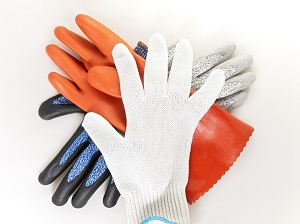If a workplace hazard assessment reveals that employees face potential injury to their hands that cannot be eliminated through engineering and work practice controls, workers must wear appropriate hand protection.
Employers should explore all possible engineering and work practice controls to prevent hazards and only use PPE, like gloves, to provide additional protection against hazards that cannot be completely eliminated through other means. For example, machine guards may eliminate a hazard. Installing a barrier to prevent employees from placing their hands at the point of contact is another method.
OSHA General Industry Standard 1910.138(a) Employers shall select and require employees to use appropriate hand protection when employees' hands are exposed to hazards such as those from skin absorption of harmful substances; severe cuts or lacerations; severe abrasions; punctures; chemical burns; thermal burns; and harmful temperature extremes.
Injuries and illnesses that can occur if workers don’t wear the correct hand protection:
- Skin Absorption of Harmful Substances
- Cuts, Lacerations, Abrasions, or Puncture Wounds
- Nerve or Tendon Damage Caused by Exposure to Vibration
- Heat Stress or Frostbite Due to Temperature Extremes
- Shocks and Burns from Electricity
- Chemical or Thermal Burns
When selecting the best work gloves to wear, remember that the gloves you choose should fit snugly.

It is essential that workers use gloves specifically designed for the hazards and tasks found in their workplace or on the job site because gloves designed for one job hazard may not protect against a different hazard. Examples of some factors that may influence the selection of protective gloves:
- Type of chemicals handled
- Nature of contact (total immersion, splash, etc.)
- Duration of contact
- Area requiring protection (hand only, forearm, arm)
- Grip requirements (dry, wet, oily)
- Thermal protection
- Size and comfort
- Abrasion and resistance requirements
OSHA Construction Standard 1926.95(a) Protective equipment, including personal protective equipment for … extremities … shall be provided, used, and maintained in a sanitary and reliable condition wherever it is necessary by reason of hazards of processes or environment, chemical hazards, radiological hazards, or mechanical irritants encountered in a manner capable of causing injury or impairment … through absorption, inhalation or physical contact.
When selecting hand protection to use at work consider the following fabric properties of the gloves that will be available by the manufacturer:
- Chemical Resistance
- Thermal Protection
- Cut and Puncture Resistance
- Non-Electrical Conductivity
Gloves contaminated with flammable or combustible materials should not be used around hot work operations or while working near an ignition source.
Gloves made from a wide variety of materials are designed for many types of workplace hazards. In general, gloves fall into four groups:
- Gloves made of leather, canvas or metal mesh
- Fabric and coated fabric gloves
- Chemical- and liquid-resistant gloves
- Rubber insulating gloves
Sturdy gloves made from leather, canvas or metal mesh provide protection against cuts and burns. Leather or canvas gloves can protect against sustained heat. Leather gloves protect against sparks, moderate heat, blows, chips and rough objects.
Aluminized gloves provide reflective and insulating protection against heat and require an insert made of synthetic materials to protect against heat and cold. Aramid fiber gloves protect against heat and cold, are cut- and abrasive-resistant and wear well. Synthetic gloves offer protection against heat and cold, are cut- and abrasive-resistant and may withstand some diluted acids, but these materials do not stand up against alkalis and solvents.

Gloves made from fabric and coated fabric are created from cotton or other fabric to provide varying degrees of protection. Fabric gloves protect against dirt, chafing and abrasions, but do not provide sufficient protection for use with rough, sharp or heavy materials.
Coated fabric gloves are normally made from cotton flannel with a plastic coating on one side offering general-purpose hand protection with slip-resistant qualities. These gloves are used for tasks like handling bricks and wire or chemical laboratory containers.
Made with different kinds of rubber, chemical- and liquid-resistant gloves can protect against chemical exposure hazards. As a general rule, the thicker the glove material, the greater the chemical resistance but thick gloves may impair grip and dexterity, having a negative impact on safety.
When selecting gloves to protect against chemical exposure hazards, always check with the manufacturer or review the manufacturer’s product literature to determine the gloves’ effectiveness against specific workplace chemicals and conditions.
More information can be found on rubber insulating gloves in OSHA Standard 1910.137. Electrical insulating gloves and sleeves or other electrical protective equipment (such as flash suits, insulating blankets) should be worn when working on electrical equipment that exposes workers to electrical shock hazards.

Workers should wear the right gloves for the job. For example:
- heavy-duty rubber gloves for concrete work
- welding gloves for welding
- insulated gloves and sleeves when exposed to electrical hazards
Protective gloves should be inspected before each use to ensure that they are not torn, punctured or made ineffective in any way. A visual inspection will help detect cuts or tears but a more thorough inspection by filling the gloves with water and tightly rolling the cuff towards the fingers will help reveal any pinhole leaks.
Gloves that are discolored or stiff may also indicate deficiencies caused by excessive use or degradation from chemical exposure. Any gloves with impaired protective ability should be discarded and replaced.

.jpeg)

.jpg)